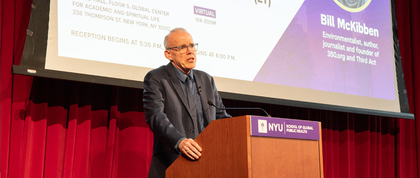
On a spring day in April 1970, beginning at the arch in Washington Square Park and stretching up Fifth Avenue to Central Park, a sea of like-minded people amassed. The same was happening across our country, an estimated 20 million Americans in the single biggest demonstration in U.S. history to demand their government take action—which it would do within 18 months—to pass the Clean Water Act, the Clean Air Act and the Endangered Species Act, and to form the Environmental Protection Agency.
“Don’t discount the power of people to get their act together and join to make things happen, even in dark and difficult times,” urged author and climate change activist Bill McKibben, who brought his compelling message to NYU GPH and NYU Shanghai, marking the 55th anniversary of Earth Day with the inaugural Distinguished Lecture on U.S.-China Cooperation on Climate and Health.
McKibben began with an apology for bearing “grim and depressing news, but there’s no point in pretending that we're not in a fix. Nothing we would recognize as a human culture has lived on our planet as hot as it is at the moment.” This sets up, among others, fire and flood conditions that are “off the charts,” and devastating epidemics around the world. He acknowledged, “We're at a moment of extraordinary danger that would not have been recognized by the people at the first earth day in 1970, who thought they were dealing with deep but correctable problems.”
But, said McKibben, there’s a fundamental difference today: “Our climate crisis is a timed test, and we have a very short window in which to solve it. Once you've melted the Arctic, no one has a good plan for how to freeze it back up again,” he added.
Although the situation is dire, there’s still hope. McKibben commended the researchers who have worked to mitigate the consequences of climate change, as well as dealing with its root cause: fossil fuels. Over the years, they have steadily lowered the price of energy from the sun and wind, and the batteries to store it. “We now live on a planet where the cheapest way to make power is to point a sheet of glass at the sun,” he said. “That is a potentially world-changing, liberating, moment; the possibilities are suddenly quite remarkable.”
But it isn’t just a possibility—it’s already a reality in some parts of the world. “In California more than 100 percent of the electric demand for large parts of the day is met by renewable resources. In April of 2025, California used 44 percent less natural gas to produce electricity than it did two years ago,” McKibben noted. “In 40 years of working on climate change, that's the single most optimistic statistic that I have heard.”
“A revolution may be underway,” he said, “But it must happen fast. In the future we'll run the world on sun and wind because it's cheap, but if it takes too long to make that happen it will be too late. So our job is to figure out how to accelerate this transition; a huge surge in renewables is not enough – we need to be 50 percent faster, which is a challenge, but not impossible.”
To accelerate that transition, McKibben stressed the need for people to join forces and make change happen. “Beside the environmental movement, in the 1960s and 1970s the other ‘group project’ was putting a man on the moon, and that was a wonderfully unifying event in a lot of ways,” McKibben said. ‘This time we don't need to put two guys on a different planet, we need to bring our local star closer to Earth to preserve this incredibly beautiful place, allowing a level of human dignity for the eight billion people we coexist with. That’s the challenge and the possibility is there, so let’s seize it,” he concluded.